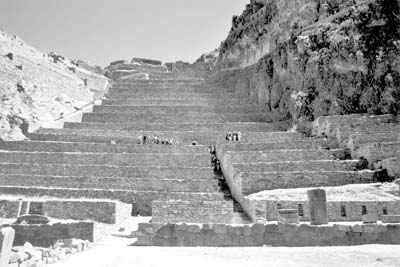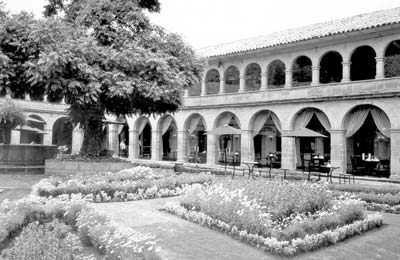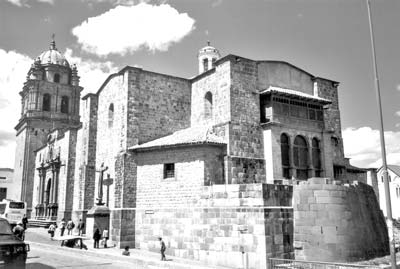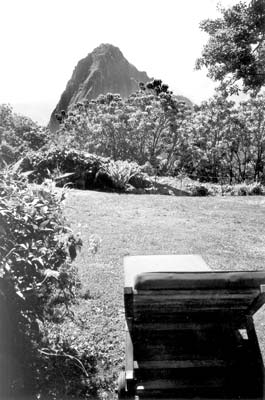Not just Machu Picchu
I can’t deny I was excited about visiting Machu Picchu. Twenty-five years had passed since my first visit. Then, torrential rains had washed away portions of the train tracks between Cuzco and the archaeological site, canceling our excursion. It took almost a week before train service was restored, and when we finally reached the site we had only a frustratingly few hours there. This time, in August 2006, I wanted enough time — weather gods permitting — to explore thoroughly and to overnight at the site to experience sunset and sunrise.
But spectacular as Machu Picchu undeniably is, I wanted to explore Cuzco too. Located 75 miles southeast of Machu Picchu, Cuzco is the jumping-off point not only for Machu Picchu but for excursions to numerous other Incan archaeological sites. Besides, Cuzco itself is chock-full of Incan memories and monuments.
Cuzco — the start
Although not readily apparent, Cuzco’s two most important churches — the Cathedral and La Compañia, both on the busy Plaza de Armas and both built in the 16th century not long after the Spanish conquest of Cuzco — sit atop Incan palaces.
Viracocha Inca was the eighth of the 13 Incan emperors who ruled between 1200 and 1533. The Cathedral was erected on the foundations of his palace. La Compañia lies atop what was once the palace of Huayna Capac, the 11th Incan emperor.
One of the best places to see substantial sections of the remarkable stonework for which the Incas are known is along Loreto, a long, narrow street leading off the Plaza de Armas. It’s lined along both sides by carefully fitted stone blocks once the outer walls of Incan buildings.
Loreto leads to Coricancha, once the Incas’ main temple, the Temple of the Sun. In the 17th century, the Church of Santo Domingo was built on top of the remaining stones. Inside the church’s cloister, smaller Incan temples as well as altars have been uncovered and can be visited.
Just outside Cuzco lies a quartet of Incan archaeological sites. At five miles outside the city, Tambomachay is the farthest. It consists of terraces and channels through which water still flows as it did 500 years ago when the Incas used this site for water ceremonies and, possibly, ritual bathing. Close by is Puca Pucara, a small fortress that probably served the Incas as a guard post as well as a hunting lodge and possibly as an “inn” for travelers.
Farther along toward Cuzco is Qenko, an intriguing complex composed of a semicircular amphitheater, caves, tunnels, altars and channels cut into the solid rock, all probably used for Incan rituals, including animal sacrifice.
Serpentine Sacsayhuaman
The gem of this archaeological quartet is Sacsayhuaman, distinguished by its trio of serpentine ramparts. Some of the stones used to construct these walls stand 11 feet high and are so perfectly fitted together that even earthquakes have failed to budge them. Although Sacsayhuaman looks like a fortress, it was more likely used for religious ceremonies.
Ten miles north of Cuzco begins the Sacred Valley of the Incas with the Urubamba River meandering through it. The Incan citadels of Pisac and Ollantaytambo perch high above the river.
The closer of the two is Pisac, about 20 miles northeast of Cuzco. Try to go on a Sunday when the market in Pisac village is in full swing (there are lesser markets there on Tuesday and Thursday), offering colorful weavings, wool ponchos, black-and-white ceramics, fruit, flowers and vegetables. It’s a photographer’s dream come true.
Just outside town are the Pisac ruins, a complex that once included a city as well as a citadel and a religious center. At the very top of the layered terraces is the ceremonial section where the Temple of the Sun and the Temple of the Moon were located. The hundreds of holes dotting the hillside across the gorge from the citadel are Incan tombs emptied long ago by grave robbers.
Sixty miles northwest of Cuzco lies Ollantaytambo, another Incan fortress-city. What was once the city lies beside the river together with a palace thought to have been built by Pachacuti, the ninth Incan ruler. The fortress and temples were located high up on the mountainside above the steep agricultural terraces.
And Machu Picchu
Finally, the queen of them all: Machu Picchu! Whatever you’ve heard about Machu Picchu is true. Spectacular. Awesome. Beautiful. It is one of the world’s most famous archaeological sites and rightly so.
Rediscovered in 1911 by American archaeologists, Machu Picchu lay undisturbed for five centuries, covered by jungle high up above the Urubamba River, nestled between two peaks. Like Pisac and Ollantaytambo, it was probably a city surrounded by agricultural terraces as well as a fortress and ceremonial center.
On the afternoon we arrived, my husband, Paul, and I explored Machu Picchu with a guide who identified the key sites: Temple of the Sun, Central Plaza, Temple of the Three Windows, Sacred Plaza and the Intihuatana, once used as an astronomical calendar. But the next day we returned to wander through the ruins on our own. We meandered through stone rooms that once may have been Incan “apartments,” got lost in maze-like corridors and climbed precipitously steep steps for spectacular views over the site.
As for the sunset and sunrise we had gone there to see, mist that gradually turned into a light rain fell toward dusk, turning the mountain peaks and the ruins into an impressionistic painting. It was magical. At sunrise, fog shrouded the ruins, but it kept lifting and shifting providing snapshot glimpses of the peaks and the site. It too was magical. Sometimes what you don’t get is exactly what you want.
If you go. . .
Our trip to Cuzco was special. What made it extra special was where we stayed. For one week, Hotel Monasterio was our home. And what a home! Originally built as a monastery in 1592 on the site of an Incan palace, the Monasterio has been part of the prestigious Orient-Express family of deluxe hotels since 1999.
Everything about the Monasterio is elegant, from the huge, Spanish colonial-style lobby bar with its stone fireplace and comfy sofas to the guest rooms, most located around one of the Monasterio’s four patios. However, our stylish room was tucked away in a corner, with French doors opening onto a quiet private veranda.
There are two restaurants: El Tupuy, appropriately once the old monastery’s refectory, and Illariy, for al fresco lunches or candlelight dinners beside the main patio.
Other touches of elegance — the splendid 17th-century Baroque Chapel of San Antonio Abad; authentic Cuzqueña paintings in the public rooms and guest rooms; a “menu” of massages for relaxation, even oxygen piped into your room (unique among Cuzco hotels) to help counteract the effects of Cuzco’s 11,000-foot altitude.
The Monasterio’s location can’t be beat either: a 5-minute walk from the Plaza de Armas in the center of town. To say we loved staying here would be an understatement.
All this does not come cheap. Room rates at the Monasterio start at $405 plus a 10% service charge, but we felt it was worth every cent. Buffet breakfast is included.
The Hiram Bingham
The train I would recommend you take to reach Machu Picchu is the Hiram Bingham. Named in honor of the American discoverer of the archaeological site, this train is the luxury option for the 3½-hour journey from Cuzco.
What a way to go: gourmet brunch on the way to Machu Picchu, gourmet dinner returning, onboard entertainment on the return, plush table settings and seating, bus transfers, and entrance fees to the archaeological site! We paid $495 per person — pricey but worth it.
We overnighted at the Sanctuary Lodge on top of the mountain, about a 2-minute stroll from the entrance to the archaeological site. The lodge is small (only 31 rooms) and rustic casual in atmosphere, with a lovely garden and killer views of the Andes. It’s also enormously expensive. Rooms begin at $715 per night. However, this does include everything: breakfast, dinner, afternoon tea, 10% service charge, all beverages (including wines), even the chocolate bars in the room mini-bar.
For reservations for the Monasterio, the Sanctuary Lodge and the Hiram Bingham train, contact Orient-Express Hotels (10 Weybosset St., Providence, RI 02903; 800/524-2420, e-mail greatjourneys@oeh.com or visit www.orient-express.com).
Cuzco day trips
Our excursions with a private guide in and around Cuzco were arranged in advance by Latin American Escapes (3209 Esplanade, Ste. 130, Chico, CA 95973; 800/510-5999 or 530/879-9292, www.latinamericanescapes.com), a company specializing in Latin American travel that we have used for numerous previous trips (Bolivia, Chile, Nicaragua and Panama).
Latin American Escapes also arranged our flights and our hotel accommodations in Lima at the elegant Country Club Lima, where our room for four nights overlooked the golf course and came with an enormous terrace. Room rates begin at $169. Don’t miss the hotel’s fabulous formal tea, served late every afternoon. You won’t want dinner after this tea. The cost for tea for two will be about $35.
We flew LAN Peru (866/435-9526, www.lan.com) between New York’s JFK and Lima. LAN Peru has introduced fully reclining seats in its business class. Upgrade, if you possibly can. The flights both going and returning were overnight, and what a difference it made to lie horizontally and snooze. Meals were superior and so were the Chilean wines.
—Focus on Archaeology is written by Julie Skurdenis




